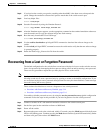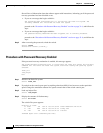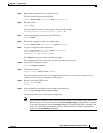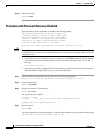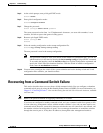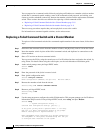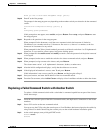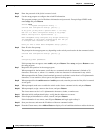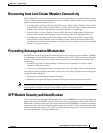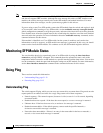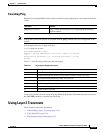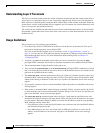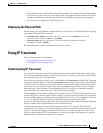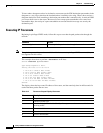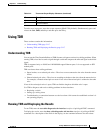
31-11
Catalyst 2960 Switch Software Configuration Guide
78-16881-01
Chapter 31 Troubleshooting
Recovering from Lost Cluster Member Connectivity
Recovering from Lost Cluster Member Connectivity
Some configurations can prevent the command switch from maintaining contact with member switches.
If you are unable to maintain management contact with a member, and the member switch is forwarding
packets normally, check for these conflicts:
• A member switch (Catalyst 3750, Catalyst 3560, Catalyst 3550, Catalyst 3500 XL, Catalyst 2970,
Catalyst 2960, Catalyst 2950, Catalyst 2900 XL, Catalyst 2820, and Catalyst 1900 switch) cannot
connect to the command switch through a port that is defined as a network port.
• Catalyst 3500 XL, Catalyst 2900 XL, Catalyst 2820, and Catalyst 1900 member switches must
connect to the command switch through a port that belongs to the same management VLAN.
• A member switch (Catalyst 3750, Catalyst 3560, Catalyst 3550, Catalyst 2970, Catalyst 2960,
Catalyst 2950, Catalyst 3500 XL, Catalyst 2900 XL, Catalyst 2820, and Catalyst 1900 switch)
connected to the command switch through a secured port can lose connectivity if the port is disabled
because of a security violation.
Preventing Autonegotiation Mismatches
The IEEE 802.3ab autonegotiation protocol manages the switch settings for speed (10 Mbps, 100 Mbps,
and 1000 Mbps, excluding SFP module ports) and duplex (half or full). There are situations when this
protocol can incorrectly align these settings, reducing performance. A mismatch occurs under these
circumstances:
• A manually set speed or duplex parameter is different from the manually set speed or duplex
parameter on the connected port.
• A port is set to autonegotiate, and the connected port is set to full duplex with no autonegotiation.
To maximize switch performance and ensure a link, follow one of these guidelines when changing the
settings for duplex and speed:
• Let both ports autonegotiate both speed and duplex.
• Manually set the speed and duplex parameters for the ports on both ends of the connection.
Note If a remote device does not autonegotiate, configure the duplex settings on the two ports to match. The
speed parameter can adjust itself even if the connected port does not autonegotiate.
SFP Module Security and Identification
Cisco small form-factor pluggable (SFP) modules have a serial EEPROM that contains the module serial
number, the vendor name and ID, a unique security code, and cyclic redundancy check (CRC). When an
SFP module is inserted in the switch, the switch software reads the EEPROM to verify the serial number,
vendor name and vendor ID, and recompute the security code and CRC. If the serial number, the vendor
name or vendor ID, the security code, or CRC is invalid, the software generates a security error message
and places the interface in an error-disabled state.



